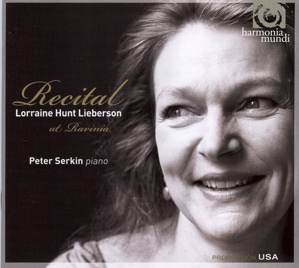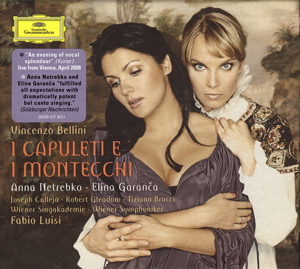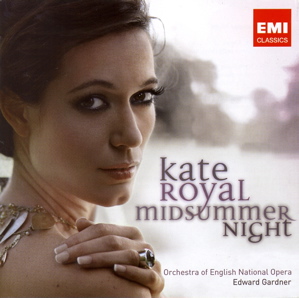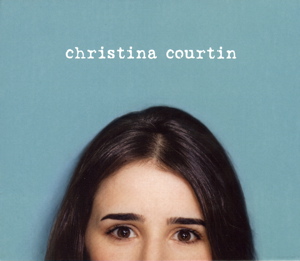Lorraine Hunt Lieberson Recital at Ravinia Harmonia Mundi USA HMU 907500
- Performance:

- Sound:


Why did we have to wait until after Lorraine Hunt Lieberson’s passing to receive so many live, un-doctored documents of her greatness? The live 2004 Ravinia performance of her husband Peter Lieberson’s Rilke Songs (Bridge) was the first to arrive after the San Francisco-born mezzo died of cancer on July 3, 2006 at age 52. Then came her November 2005 live performance of Lieberson’s Neruda Songs (Nonesuch). Since then, Spanish Love Songs from Caramoor 2004 (Bridge), two Wigmore Hall recitals from 1998 and 1999 (WHLive), John Harbison’s North and South: Six Poems of Elizabeth Bishop (Naxos), a CD of her Handel and Bach at Emmanuel Music from 1992 and 1995 (Avie), and a recently-released 1990 recording of Schumann songs and duets (Koch) have further cemented her reputation as the artistic equal of her two great English mezzo-soprano predecessors, Kathleen Ferrier and Janet Baker.
Now comes what some will consider the crown jewel: a recital from Chicago’s Ravinia Festival. Wonderfully recorded on August 5, 2004, it captures both Hunt Lieberson’s voice and Peter Serkin’s pianism at their fullest. The performance begins with three songs by Brahms, and ends with Robert E. Telson’s “Calling You†from Baghdad Café. In between come Handel, Debussy, Mozart, and a gratifyingly unaffected performance of Burleigh’s “Deep River.â€
If the performance of Brahms’ “Unbewegte laue Luft†(Motionless balmy air), Op.57, No.8 only achieves 90% of the miraculous intimacy heard in Hunt Lieberson’s recital of all eight Op.57 songs at Wigmore Hall, it’s undoubtedly because she took the risk of opening with such a passionate, transcendently beautiful declaration of love. Then again, look at the high standard I’m holding her against. It’s like trying to decide which of Callas’ performances of Norma, Traviata, or Tosca was best.
Once fully settled in, Hunt Lieberson invests her two other Brahms songs with unsurpassable communicative power. If Ameling is more radiant and exquisite in her phrasing of “Ruhe, Süssliebchen, im Schatten†(Rest, my love, in the shade), Hunt Lieberson is warmer and more nurturing. (Serkin’s glistening treble tones create an especially magical counterpoint). As for “Von ewiger Liebe†(Of Eternal Love), note how intimate and sweet she becomes after the dramatic outpouring in the middle of the song. Ferrier, Baker, Lotte Lehmann, Thomas Allen and others may be equally compelling, but not greater.
If you play the three excerpts from Handel’s La Lucrezia HWV 145 over a good sound system, you will hear Hunt Lieberson’s heart crying in desperation. Equally remarkable is her transition from soft tenderness to unbridled anger and vengeance. Few singers can ask so much of their instrument without sacrificing either smoothness of emission or beauty of tone. That she could so convincingly transition to the intimate sensuality of Debussy’s Trois Chansons de Bilitis is miraculous. To these ears, the supreme intimacy of her “Le chevelure†(The Hair) surpasses the achievement one of Debussy’s chosen Melisandes, Maggie Teyte.
That is not to say that she can summon up quite the virginal innocence and purity of tone required for Mozart’s “Dans un bois solitaire†(In a Lonely Wood). But her “Abendempfindung†(Evening thoughts), although unusually slow, achieves a level of intimacy and youthfulness at age 50 that eludes Schwarzkopf and a host of other great Mozartians. Serkin’s tone, again, is perfect. Note the mezzo’s emotionally and technically ideal crescendo on the words “in meinen Diademe,†and Serkin’s wonderful, almost hesitant solo conclusion. The choice of tempo may not be to everyone’s taste – her duet with countertenor Drew Minter on Handel’s “Son nata a lagrimar†(I was born to weep) from Giulio Cesare is also very, very slow – but the artistry is consummate.
Bonuses, besides a rare chance to hear excerpts from Mozart’s Eine kleine deutsche Kantate (A Little German Cantata), include Hunt Lieberson’s spoken introductions to the last three selections, and the final encore, “Calling You.†San Francisco Opera cellist Emil Miland, who was one of Hunt Lieberson’s dearest friends, recalls visiting her in Santa Fe while she was ill. One day, Lorraine said to him, “I want to sing this for you.†Seating herself at the piano, she performed the very same song. I can only imagine what it must have felt like to be sitting so close when she sang with such sincerity as she faced death head on. What a wonderful way to say farewell.
Joel Fan Music of the Americas Reference Recordings RR 119
- Performance:

- Sound:


Pianist Joel Fan, a longtime member of Yo-Yo Ma’s genre-busting Silk Road Ensemble, has just released West of the Sun: Music of the Americas. Given Fan’s predilection for colorful repertoire, this new disc, his second CD on Bay Area-based audiophile label Reference Recordings, is likely to follow his initial release, World Keys: Virtuoso Piano Music, to the top of the Billboard classical charts.
Born in New York City in 1969 to Taiwanese parents, Fan first performed with the New York Philharmonic at age 11. His subsequent musical education, which included the Juilliard School, Harvard University (where he studied with Leon Kirchner), and the Peabody Conservatory (where he studied with Leon Fleisher), led to prizes at the D’Angelo Young Artists International Competition in the United States and Busoni International Piano Competition in Italy.
Fans’ commitment to a wide range of repertoire leads him to easily traverse the distance between world music, classical music of the 21st century, and music by Schumann and Beethoven. In 2006, he performed Beethoven’s Triple Concerto with Ma and the New York Philharmonic under David Zinman, and gave the world premiere of Leon Kirchner’s Sonata No. 3, “The Forbidden,” at Pickman Hall in Cambridge, Massachusetts. Just last month, he presented the New York premiere of William Bolcom’s oft-droll Nine New Bagatelles in a New York club setting as part of a CD release party for West of the Sun.
The shortest of Bolcom’s nine bagatelles, (…take no prisoners), slayed this listener with 21 seconds of cheekiness. Bolcom’s babies are but one of nine works on a CD that starts off in a lighthearted dancing mood. First up is Brazilian Ernesto Nazareth’s Vem cá Branquinha, a snappy tango that lifted one of its themes from a tango popularized at Brazil’s 1906 Carnival. Alongside such equally short works as New Orleans-born Louis Moreau Gottschalk’s light-hearted Suis-moi! Caprice (1861), Argentinean-born but New York-raised Astor Piazzolla’s insinuating Flora’s Game (Milonga Prelude) (1987), Brazilian Heitor Villa-Lobos’s beautiful Chôros No. 5, “Alma Brasileira†(1925), Mrs. H. H. A. Beach’s darting Fireflies (1915) – not as sparkling as a fleeter recording by Alan Feinberg, but lovely nonetheless – and African-American Margaret Allison Richardson Bonds’ Troubled Water (1967), based on the Negro spiritual “Wade in the Water,†are the CD’s two most substantial works: Argentinean Alberto Ginastera’s compelling Sonata No. 1 (1952) and Samuel Barber’s stunning four-movement Piano Sonata, Op. 26 (1949).
Fan’s rendition of Barber’s technically challenging sonata, whose knockout last movement was written at the insistence of Vladimir Horowitz, is the performance by which most listeners will judge his achievement. He acquits himself wonderfully, even when compared to Horowitz and speed demon Marc-André Hamelin. The Adagio is especially touching, and becomes more moving with repeated listening. Fan also manages to play for the hair-raising final Allegro one second faster than Horowitz and seven seconds faster than Hamelin, yet never sacrifices musical coherence for dazzle. This state-of-the-art recording makes me hope that Fan will soon return to the Bay Area, not just to record a third CD at Skywalker Studios, but also to perform a full-length recital.
Bellini La Sonnambula Decca 001238302
- Performance:

- Sound:


La Sonnambula (The Sleepwalker) endures as one of the greatest operas of the bel canto era. So glorious is Bellini’s melodic flow, and so touching the sentiment, that the implausibility of Romani’s libretto is cast aside as long as the leads observe the inviolable tenets of bel canto artistry: beauty of vocal production, variety of expressive nuance, and elegance of vocal ornamentation must remain paramount.
Those of us familiar with the opera and its 1831 Hit Parade of Tunes expect to hear a high-flying soprano soar as Amina . Yet, according to the liner notes for Decca’s new recording of the opera in which mezzo-soprano Cecilia Bartoli sings Amina opposite tenor Juan Diego Flórez’s Elvino and bass Ildebrando D’Arcangelo’s Count Rodolfo, Amina was initially sung by mezzo-sopranos Giuditta Pasta and Maria Malibran. Bartoli’s is thus the first Sonnambula recording to restore the female lead to its mezzo origins.
It is also the first played on period instruments tuned to historically accurate pitch of ‘a’ = 430 Hz, and the most revelatory since Maria Callas’ commercial and live versions revivified the work in the 1950s . Bartoli’s Amina is not only the most limpidly sung and technically astounding since Sutherland’s, but also among the most expressive on record. Her fioriture (variations and embellishments) are so cannily worked out, the gradations of volume and tonal shading so exquisite, and the top of her voice so lovely, that you will not likely miss the high E flats.
There is never a sense that Bartoli throws in trills, runs, and all the rest for the sake of showmanship. Rather, each vocal ornament and dynamic gradation serves a dramatic purpose. You may be surprised to discover three of her duets with Flórez, including the gorgeous “Prendi: l’anel ti dono†(My Love: I give you the ring), transposed down. (Don’t miss the ’78 version with dal Monte and Schipa). I suppose the transposition allows her to move easier in her high range, but it robs Flórez of some brilliance. Equally surprising is Bartoli’s extremely slow tempo for “Ah! non credea mirarti†(I hadn’t thought I’d see you), and her downward rather than upward ornamentation in the exultant “Ah! non giungeâ€Â (Ah, human thought cannot conceive) at the opera’s conclusion. But her accomplishment is thrilling.
Flórez is, as expected, a miracle. Perhaps inspired by Bartoli, and/or freer to vary dynamics when not trying to fill the cavernous Metropolitan Opera House, he delivers a far more nuanced portrayal than in his marvelously sung recent live Met HD telecast opposite Dessay. D’Arcangelo sings beautifully, conveying the above-it-all authority of the count who takes the high road rather than playing the lecher, but sacrifices expressivity for speed in his big aria, “Vi ravviso, o luoghi ameni†(O lovely scenes, again I see you). Listen to Boris Christoff’s rendition on YouTube for a telling comparison.
Unbounded praise for the beautiful playing of Orchestra La Scintilla. Alessandro De Marchi lovingly allows his diva all the space and support her creativity requires. Though the repeated wedding bell tinkles become precious, the orchestra’s little woodwind chirps in the intro to “Prendi: l’anel ti dono†are cause for rejoicing. As is the recording itself.
Note: A survey of recordings of Amina’s arias that begins with the acoustic era (Galli-Curci, Tetrazzini, Sembrich, Kurz, and de Hidalgo), extends through the age of early electric ‘78s (dal Monte and Muzio), and culminates in the LP and digital age (Callas, Sutherland, Dessay, Moffo, Swenson, et. al.) reveals that, until Bartoli, only sopranos have recorded the role. Mezzo-soprano Frederica von Stade performed Amina in San Francisco in 1984, but never recorded the opera.
Bellini Capuleti e i Montecchi Deutsche Grammophon 4778031
- Performance:

- Sound:


Why Bellini’s I Capuleti e i Montecchi (The Capulets and the Montagues) is so infrequently staged becomes apparent once you hear Deutsche Grammophon’s new recording. Although the beautifully sung performance stars the enticing triple bill of soprano Anna Netrebko (who next month returns to San Francisco’s War Memorial Opera House in Verdi’s La Traviata) as Giulietta, fast-rising mezzo-soprano Elina Garanca (just seen in the Met’s La Cenerentola) as Romeo, and tenor Joseph Calleja as Tebaldo, the music as a whole is not the most inspiring.
Parts of the opera are not only beautiful, but also marvelous vehicles for the female voice. The Act One section that begins with Giulietta’s gorgeous recitative and aria, “Eccomi in lieta vesta… Oh! Quante volte†(Here I am dressed for a celebration…Oh, how many), and picks up steam as the two women go to it for all its worth, is one of the most arresting in the opera. So too is Act Two’s final tomb scene, when Romeo and Giulietta pour out their grief. But the choruses are often workman-like, and the men’s music less than memorable.
Netrebko, with whom I chatted briefly last week, believes that I Capuleti e i Montecchi is “one of the most beautiful operas ever written.†Yet even she acknowledged that the libretto, based on an Italian play by Luigi Scevola (1818) rather than Shakespeare’s classic, is best performed in concert rather than fully staged because some of it is “boring.â€
Only stellar artistry can bring this opera to life. Certainly Netrebko has a beautiful voice that speaks with utmost sincerity. If you didn’t hear other sopranos in the role, she might fool you into thinking that her generalized interpretation says it all. But if you compare her rendition of Giulietta’s great recitative and aria with a rare 1968 recording by Beverly Sills featuring the Köln Opern Chor and Köhn Radio Sinfonie Orchester conducted by Ernst Marzendorfer, or even to Sills’ live Boston performance from 1975, when she was well past her best, you will discover what’s missing. In additional to all of the Brooklyn soprano’s technical accomplishments – an astounding trill; shimmering, iridescent head tones that ravish the senses; and ease of embellishment – there is an emotional depth and specificity of character to which Netrebko can only aspire.
Garanca has a great voice with all the thrust that Romeo requires. But compared to Tatiana Troyanos, whose voice is too sensually voluptuous for this trouser role, Garanca does not portray suffering in ways that rip you apart. Calleja’s voice is as sweetly perfect as any I’ve heard, but often too light to fully express Tebaldo’s feelings. Why is there a frequent smile on the voice of Robert Gleadow (Lorenzo) when he is supposed to express something very different? Fabio Luisi does a fine job conducting the Wiener Symphoniker, but the men of the Wiener Singakademie sometimes sound too wimpy. Conclusion: Fine recording, extremely well sung, but not all the way there.
Kate Royal Midsummer Night EMI Classics 68192
- Performance:

- Sound:


For her second EMI recital disc, elegant British soprano Kate Royal (b. 1979) gives us an album of arias from the last century. Inspired by the role of the Governess in Benjamin Britten’s gothic psychodrama, The Turn of the Screw, which she sang with Glyndebourne on Tour in 2006, Royal hones in on 20th century operatic females who, in her own words, share the Governess’ combination of “intensity and abandon.†Her 13 arias depict “worlds in which the heroines are laid bare, vulnerable in their journey towards emotional fulfillment.†They are women “lost in love [or sometimes] trapped in a deeper trance-like state as they wrestle with their unsated desires.â€
If that sounds like a parcel of tortured women screaming their hearts out, rest assured that a lot of the music is far lighter and more rapturous than Royal’s words suggest. Balancing the torments of the Governess and the melodrama of Samuel Barber’s Vanessa are the delights of André Messager’s “Rossignol,†aka “Philomel,†from Monsieur Beaucaire and the romantic tug of “Marietta’s Lied†from Erich Korngold’s Die tote Stadt.
From the first notes of the title aria, William Alwyn’s atmospheric “Midsummer night†from Miss Julie, it is hard not be seduced by Royal’s gifts of tonal beauty and heartfelt commitment. There is an emotionally grounded quality to her singing, an unforced connection between throat and heart that bespeak both purity and maturity. It’s a wonderful voice, from a woman whose beauty clearly extends far beyond surface allure. The three Britten selections, including excerpts from Paul Bunyan and Peter Grimes, are marvelous, as is Stravinsky’s “Nightingale aria†from The Nightingale. There’s nothing in this recital that I wouldn’t want to savor many times over.
Questions arise, however, as Royal approaches the top of her range. While her highs are definitely more solid and pleasing than in her first recital, there’s a desperation in the high C of “at the haunted end of the day†from William Walton’s Troilus and Cressida that suggests a fear deeper than the priestess’s. Other highs, such as the final B in the “Vilja-Lied†from Franz Léhar’s The Merry Wives of Windsor and the C# in Dvorak’s “Song to the Silver Moon†from Rusalka, are neither held as long nor as rapturously as one might wish.
Inevitably, comparisons loom. Of current sopranos, Renée Fleming’s slower treatment of the Dvorak, which she recorded when close to Royal in age, sinks far deeper, and her C# is glorious. In Marietta’s unforgettable melody, no one can replace Sills, or, reaching back in time, Lehmann with Tauber. Who can out prima donna Leontyne Price in the Barber? And Royal only hints at the lightness and charm that one of Messsager’s chosen sopranos, Maggie Teyte, aka “l’Exquise†(the exquisite one), could still summon forth as she neared 60. But when all is said and done, this is a glowing recital by a gifted soprano who matches beautiful sound with emotional depth.
Various And If the Song Be Worth a Smile: Songs by American Composers Pentatone SACD 5186099
- Performance:

- Sound:


Â
Pentatone Classics has issued a veritable bonanza of recent American song by living American composers. And If The Song Be Worth A Smile, which takes its name from a line in Gordon Getty’s setting of his poem “The Ballad of Poor Peter,†features songs by William Bolcom, Jake Heggie, David Garner, John Corigliano, Luna Pearl Woolf, and Getty. All but Bolcom and Heggie’s creations receive their much-deserved recording premieres.
This essentially Bay Area effort includes notes by Clifford (Kip) Cranna; performances by soprano Lisa Delan and pianist Kristin Pankonin, both graduates of the San Francisco Conservatory of Music; and additional contributions from Bay Area-bred cellist Matt Haimovitz and, in one duet, mezzo-soprano Susanne Mentzer. Distinguished by direct, clear sound that resists any temptation to over-reverb what are essentially intimate performances, the Skywalker Studios recording comes in high-resolution, optional multi-channel SACD format.
Getty’s Poor Peter cycle of three songs first. Given that the composer is also a major philanthropist in matters musical and more, and deserves our immeasurable gratitude, it is not unreasonable to expect a critic to soft-pedal any qualms they may have about his compositions. I thus state, with utmost sincerity, that these three songs are immensely enjoyable. Sung with considerable feeling by Delan, Getty’s vision of Elizabethan England (or thereabouts) is distinguished by haunting lyricism and, in “Tune the Fiddle,†body-engaging rhythms. Thoughts of Poor Peter begging for a penny may generate wry smiles, but one was probably on Getty’s face as well as he took pen in hand.
Some of Bolcom’s marvelous Cabaret Songs, to poems by the late and brilliantly witty Arnold Weinstein, have received numerous recordings since their premieres by the great Joan Morris. No less distinguished sopranos than Dawn Upshaw and Measha Brueggergosman have joined Morris and Bolcom in recording the flirtatious “Amor;†Brueggergosman has also tackled “Toothbrush Time.†Delan’s versions are considerably less operatic, and have a compelling energy all their own.
Delan also gives her all to four folk song and folk song-like settings by Heggie, many of which were written for Frederica von Stade. (It is difficult not to listen to these without imagining Flicka’s unique sound and soulful sensibility). If Delan’s voice is neither the most comfortable at the top of the range, nor consistently alluring, it is nonetheless handled with such intelligence as to merit kudos.
Haimovitz’s rich, evocative cello joins Pankonin and Delan on “Im Grasse,†the first of SFCOM professor David Garner’s three Annettes-Lieder. Of these beautiful settings of poems by Annette von Droste-Hülshoff, I find the soothing if conventional melody of “Der Weiher†(The Weir) irresistible. Garner’s gems provide fitting contrast to Corigliano’s two droll Cabaret Song settings of poems by his partner Mark Adamo. Luna Pearl Woolf’s 10-minute setting of Pablo Neruda’s “Odás de Todo el Mundo†(Odes of All the World) – a vocal tour de force that taxes Delan’s resources – makes for an animated conclusion.
The above reviews initially appeared at San Francisco Classical Voice (sfcv.org)


